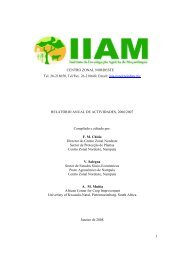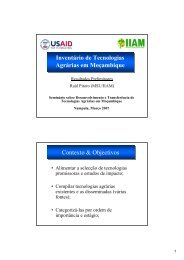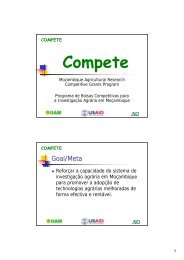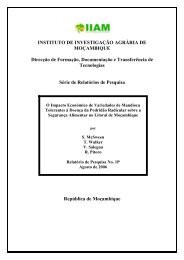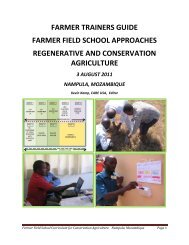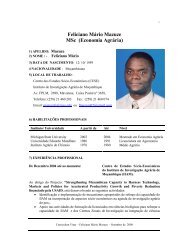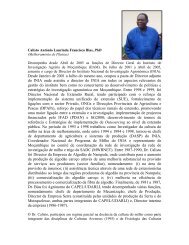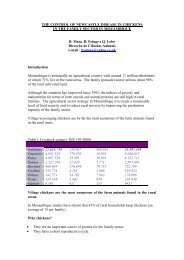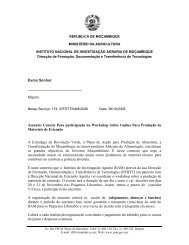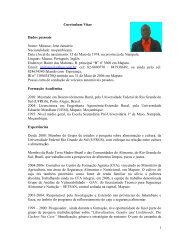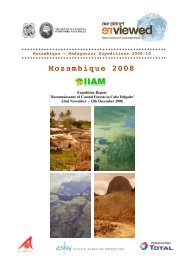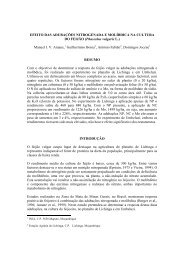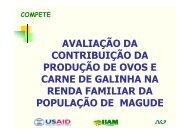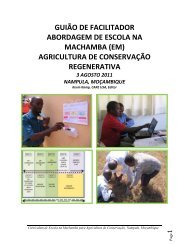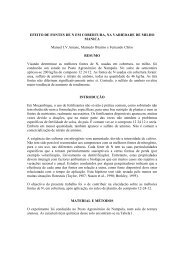A case study from Mozambique
A case study from Mozambique
A case study from Mozambique
Create successful ePaper yourself
Turn your PDF publications into a flip-book with our unique Google optimized e-Paper software.
INITIATIVES FOR DEVELOPMENT OF AGRICULTURAL<br />
INFORMATION MANAGEMENT TO POLICY – MAKERS:<br />
A CASE STUDY FROM MOZAMBIQUE<br />
Paula Pimentel, Sostino Mocumbi e Marta Francisco<br />
Directorate of Training, Documentation and Technology Transfer (DFDTT)<br />
Agricultural Research Institute of <strong>Mozambique</strong> (IIAM), Maputo, <strong>Mozambique</strong><br />
Introduction<br />
The agriculture sector in <strong>Mozambique</strong> plays a dominant role in fuelling the national economic<br />
development drive. It accounts not only for the largest share of rural employment, but also for greater<br />
part of food production, for the production of agricultural raw materials to sustain local industries and for<br />
external markets. Despite that, however, agricultural productivity is very low, largely due to the backward<br />
production techniques used by the small farmers that constitute the majority of the agricultural<br />
community (MINAG, 2007).<br />
The Government of <strong>Mozambique</strong> (GoM) has given high priority to the sector as the main tool for<br />
attaining the national goal of accelerated economic development, poverty alleviation and the sustainable<br />
use of natural resource base. A national program has been launched, called «The Green Revolution»<br />
which drives the development policies for the sector. However, for the success of these initiatives and<br />
development strategies, various measures have to be taken and one of these relates to streamlining and<br />
strengthening the national information and communication systems.<br />
In line with this, it is recommended to set up well coordinated and effective linkages and actions between<br />
the different information management systems which have been established in different institutions within<br />
the agricultural sector or other relevant economic sectors.<br />
Key Concepts and Major Propositions<br />
This section has the objective to present and to clarify some key concepts and briefly state some of the<br />
major propositions concerning the topics of this paper, which are: the importance to sharing agricultural<br />
knowledge, identify and describe existent information systems in <strong>Mozambique</strong> and recommend measures<br />
and mechanisms to improve synergies and coordination among different actors, including policy-makers.<br />
2 nd Africa Conference of the International Association of Agricultural Information Specialists (IAALD) –<br />
Africa Chapter. Paper presented at the Pre-Conference Workshop organized by FARA - RAILS Program,<br />
“Opening Access to Agricultural Information and Knowledge: sharing the experience of the NARS”. Ghana.<br />
Accra. 12 – 17 July. 2009<br />
1
There are a number of premises to establish an effective information and communication system (AKIS).<br />
One of these premises is that there exists an agricultural knowledge and information system with the<br />
mission of improving agricultural production by generating, transferring, and using effective agricultural<br />
technologies. AKIS is defined as a set of agricultural organizations and/or persons, and the links and<br />
interactions between them, that are engaged in such processes as the generation, transformation,<br />
transmission, storage, retrieval, integration, diffusion and utilization of knowledge and information with<br />
the purpose of working synergically to support decision-making, problem solving and innovation in a<br />
given country´s agriculture or a domain thereof (Röling, 1990).The elements and actors of AKIS are:<br />
research organizations, technology transfer and advice providers, farmer´s organizations, nongovernmental<br />
organizations (NGO´s), farmers and policy-makers. In addition to these actors, there are<br />
many other stakeholders in the agricultural knowledge and information systems, including donors, who<br />
have interests in it and can influence direct or indirectly it.<br />
Another important premise is that communication is crucial in development and is often about more than<br />
providing information. It is about fostering social awareness and facilitating public democratic dialogue.<br />
It is about contributing to evidence – based policy, and about building a shared understanding which can<br />
lead to social change. It is about creating space for all the voices to be heard, mostly the poor, and<br />
ultimately about redistributing power. Better communication may also need to be accompanied by<br />
improving existent communication and information system, knowledge management and promotion of<br />
capacity building for evidence based policies (Hovland, 2005)<br />
A third premise that can be referred is that, for effectiveness, synergy is the mode of functioning of the<br />
system and linkages are crucial for synergy. Linkages are here defined as the channels for the two way<br />
flow of knowledge, information and resources among AKIS partners.<br />
Furthermore, all stakeholders and actors should recognize the need and identify clear benefits for linking<br />
to each others, either to disseminate and provide information and data or to obtain and to have access and<br />
use of appropriate information. The willingness of an organization to invest in linkages with other<br />
organizations in an information and communication platform, may also be a function of the degree of its<br />
awareness (Eponou, 1996).<br />
To sustain linkages it is advisable that structural and managerial devices or procedures are used,<br />
coordination mechanisms identified and established, and this may commonly be referred as linkage<br />
mechanisms. Research institutions may also develop and implement specific linkage policy.<br />
In <strong>Mozambique</strong> the present status of the agriculture and natural resources information systems shows that<br />
there is a number of institutions, programs and initiatives that individually or collectively collate, analyze,<br />
store and disseminate diverse data and information on the agricultural sector of the country. However, it<br />
has been recognized that, key stakeholders and decision-makers, in the country, still lack access to<br />
relevant information. There is a need to establish coordination mechanism to harmonize diverse databases<br />
and information systems and resources.<br />
2 nd Africa Conference of the International Association of Agricultural Information Specialists (IAALD) –<br />
Africa Chapter. Paper presented at the Pre-Conference Workshop organized by FARA - RAILS Program,<br />
“Opening Access to Agricultural Information and Knowledge: sharing the experience of the NARS”. Ghana.<br />
Accra. 12 – 17 July. 2009<br />
2
The next section briefly describes some of the food, agriculture and natural resources information systems<br />
or related databases in <strong>Mozambique</strong> and initiatives to strengthen its relevance to policy development and<br />
decision making.<br />
Information Management Initiatives: <strong>Mozambique</strong>´s present situation<br />
In <strong>Mozambique</strong> food, agriculture and natural resources (FANR) management plays an important role in<br />
driving country´s economic growth and the Government has given high priority to the development of<br />
coordinated and comprehensive FANR development strategies. While most of the Ministries play a role<br />
for the agricultural development in the country, the main Ministries responsible for FANR are the<br />
Ministry of Agriculture, Ministry of Planning and Rural Development, Ministry of Health and Ministry of<br />
Tourism. Important activities related to FANR are also implemented by the Ministry of Environment,<br />
Ministry of Commerce and Industry and Ministry of Science and Technology, among others.<br />
There are several database and information management systems in some of these ministries, principally<br />
in the Ministry of Agriculture. However, there is no an integrated national system for agricultural<br />
information management.<br />
The following are the most important and well known information and data sources in <strong>Mozambique</strong>:<br />
1. Remote Sensing Database System and Geographic Information Systems (GIS)<br />
Different institutions use the remote sensing system to collect data and satellite images to develop and<br />
provide information to different users. Information is provided in different formats as maps, web pages,<br />
reports, electronically and provide information on climate, vegetation and other land cover features.<br />
CENACARTA (www.cenacarta.com): The National Remote Sensing and Cartography Centre<br />
(CENACARTA) was created by the Council of Ministers on December 27th, 1990, as an Autonomous<br />
State Company under the Ministry of Agriculture, for the coordination of remote sensing activities in<br />
<strong>Mozambique</strong>. The status and functions of CENACARTA were revised in September 2004 (decree nº<br />
48/2004), and new responsibilities were added in the areas of geodesy, photogrammetry, cartography,<br />
aerial photography and political geography. The functions and mandate of CENACARTA are as follows:<br />
• To be a national archive of Satellite images, in the country;<br />
• To disseminate the importance and use of Remote Sensing (RS) and GIS techniques among<br />
potential users and beneficiaries;<br />
• To organize training sessions in RS and GIS;<br />
• To perform the necessary geometric correction to satellite images to be distributed to the users;<br />
• Coordination and execution of activities in the domains of the cartography, geodesy, remote<br />
sensing,<br />
• Photogrammetry and aerial photography;<br />
• Production, updating and maintenance of geocartographical information related to <strong>Mozambique</strong>;<br />
• Acquisition and processing of satellite imagery requested by the users;<br />
2 nd Africa Conference of the International Association of Agricultural Information Specialists (IAALD) –<br />
Africa Chapter. Paper presented at the Pre-Conference Workshop organized by FARA - RAILS Program,<br />
“Opening Access to Agricultural Information and Knowledge: sharing the experience of the NARS”. Ghana.<br />
Accra. 12 – 17 July. 2009<br />
3
• Organization, maintenance and updating of georeferenced databases;<br />
• Studies and technical consultancy in its domain of competence for public and private entities;<br />
• Technical and scientific research to improve methodologies and technologies the be used<br />
internally;<br />
• Maintenance and updating of the national geodetic network;<br />
• Production of aerial photography and mosaics, ortophotomaps, thematic and topographical maps,<br />
and other special maps in the appropriated scales;<br />
FEWS NET: the Famine Early Warning Systems Network is a USAID-funded activity that<br />
collaborates with international, regional and national partners to provide timely and rigorous<br />
early warning and vulnerability information on emerging and evolving food security issues. The<br />
following are the main activities and outputs of the FEWS NET, worldwide and in <strong>Mozambique</strong>:<br />
• monitor and analyze relevant data and information in terms of its impacts on livelihoods<br />
and markets to identify potential threats to food security;<br />
• a suite of communications and decision support products to help decision makers act to<br />
mitigate food insecurity;<br />
• monthly food security updates for 25 countries, regular food security outlooks, and<br />
alerts, as well as briefings and support to contingency and response planning efforts;<br />
• also focuses its efforts on strengthening early warning and food security networks,<br />
including developing capacity, building and strengthening networks, developing policyuseful<br />
information, and building consensus around food security problems and solutions;<br />
• the FEWS NET web site (www.fews.net) is the activity’s primary global vehicle for<br />
disseminating information. Regional and national monthly food security updates appear<br />
on the site along with other information and technical materials;<br />
• vulnerability and food security assessments using a livelihoods approach;<br />
• food security alerts, updates and briefings provide in-country decision-makers, USAID,<br />
United Nations, NGOs and other donors with the latest information on potential food<br />
security threats;<br />
• remotely-sensed and ground-based early warning data that are collected, analyzed and<br />
disseminated on an ongoing basis;<br />
• capacity strengthening through technical assistance to national and regional early<br />
warning systems. Areas of assistance include early warning techniques and tools, food<br />
security and vulnerability assessment methods, and contingency and response planning;<br />
• FEWS NET collaborates with agencies at the international (FAO, WFP, and EU),<br />
regional (SADC, CILSS, IGAD, Drought Monitoring Center), and national levels to<br />
improve early warning and vulnerability analysis methodologies.<br />
In <strong>Mozambique</strong> FEWS NET collaborates in close networks with the Technical Secretariat for Food<br />
Security and Nutrition (SETSAN), the Agriculture Market Information System (SIMA) and the<br />
<strong>Mozambique</strong> National Early Warning System for Food Security (Sistema de Aviso Prévio). There is a<br />
very close linkage and collaboration with national institutions like the National Institute of Meteorology<br />
2 nd Africa Conference of the International Association of Agricultural Information Specialists (IAALD) – 4<br />
Africa Chapter. Paper presented at the Pre-Conference Workshop organized by FARA - RAILS Program,<br />
“Opening Access to Agricultural Information and Knowledge: sharing the experience of the NARS”. Ghana.<br />
Accra. 12 – 17 July. 2009
and the National Institute for Management of Natural Disasters (INGC). Data and information provided<br />
by FEWS NET on <strong>Mozambique</strong> food security status, market prices and agricultural products and<br />
production is very up dated and is a good example of synergies created among different agricultural and<br />
information management systems, avoiding duplication of efforts and providing different levels of<br />
audiences.<br />
National Institute of Meteorology (INAM): provides data and information on main climate factors and<br />
conditions. Information is available by different means of dissemination like TV, newspapers, reports,<br />
web page, and analyzed and used to provide a number of alerts, updates and briefings to influence and<br />
help develop appropriate strategies and policies to sustain agricultural production and prevent food<br />
insecurity.<br />
2. National Vulnerability Assessment and Analysis Information Systems<br />
The Government of <strong>Mozambique</strong> gives particular attention and high priority to the development,<br />
implementation, monitoring and evaluation of national strategies, programs and mechanisms to<br />
reduce livelihood vulnerability, food insecurity and poverty reduction.<br />
SETSAN: the Technical Secretariat for Food Security and Nutrition is an inter-sectorial organ<br />
that was created to enhance national food security and nutrition policies formulation, development<br />
programs and emergency interventions. The SETSAN is inspired in FIVMS framework to define food<br />
security and nutrition concept. The FIVMS framework permits to establish an integrated view of food<br />
security and nutrition and helps to visualize the different interlinks of the food chain component that will<br />
define the food security situation. SETSAN conducts, together with a number of local government<br />
officers, extension agents and NGOs, food security, poverty and nutritional assessments. SETSAN also<br />
collaborates and is often supported in its activities by partners such as the World Food Program (WFP)<br />
and FAO.<br />
There is a close linkage and a memorandum of understanding was signed between the SETSAN and the<br />
Agricultural Research Institute of <strong>Mozambique</strong> (IIAM). Collaboration between the two institutions<br />
include joint teams for training activities on food security and nutrition for extension agents and local<br />
government officers, dissemination of good agricultural practices to increase productivity, post harvest<br />
improved techniques and access and use of diverse agricultural products, improved seeds and crop<br />
varieties.<br />
SETSAN dissemination and communication materials and products include: a web page<br />
(www.setsan.org.mz), Newsletter, SETSAN Baseline Annual Report, SETSAN Info Flash and<br />
Bulletin.<br />
National Early Warning System for Food Security: called Sistema de Aviso Prévio, this is a Ministry<br />
of Agriculture information system (IS) that aims at providing information on annual crop season through<br />
monitoring and evaluation of crop management activities during the crop season, estimates of crop<br />
harvest yields, identification of pests and crop losses due to sanitary and climate factors, meteorological<br />
data in agricultural research stations, among other relevant agricultural data. Several studies and surveys<br />
2 nd Africa Conference of the International Association of Agricultural Information Specialists (IAALD) –<br />
Africa Chapter. Paper presented at the Pre-Conference Workshop organized by FARA - RAILS Program,<br />
“Opening Access to Agricultural Information and Knowledge: sharing the experience of the NARS”. Ghana.<br />
Accra. 12 – 17 July. 2009<br />
5
are conducted together with NARS and Extension services, NGOs and local agricultural officers. This<br />
information system allows for policy makers to make decisions related to input supply, demand for seeds,<br />
development and implementation of appropriate measures to control pests and diseases and to prevent<br />
crop losses and food insecurity. The basic unit for data collection is the district. Information is available<br />
through Annual Reports or specific reports that are used by the Department for Agricultural Policy and<br />
Studies.<br />
3. Market and Seed Information Systems<br />
Agricultural inputs supply and market development initiatives have been greatly supported by<br />
the Ministry of Agriculture aiming at enhancing the success of the Green Revolution in<br />
<strong>Mozambique</strong>. A very dynamic and well known information and communication system has been<br />
established called:<br />
SIMA: The Agriculture Market Information System (Sistema de Informação de Mercados<br />
Agricolas=SIMA) is responsible to provide data on agricultural prices of the main crops cultivated in the<br />
country, input supply and seed availability. Information on production and demand estimates is also<br />
provided. The system is supported by up dating studies conducted by NARS and Policy Units of the<br />
Ministry of Agriculture, on market dynamics of the main agricultural products, at both national and<br />
regional level. Means of dissemination comprises of a monthly Bulletin Quente-Quente, community radio<br />
broadcasting and there is also access through mobile cell phones. Access and use has been proved to be<br />
widely spread at community level.<br />
4. Metadata and Information Systems<br />
Metadata brings advantages regarding the meaning of the information, its contents and format. It allows<br />
coherence in information sharing, improves quality of service and ensures that data is re-usable thus<br />
avoiding duplication. While some sectors may conduct their own field surveys (in <strong>Mozambique</strong> the<br />
Ministry of Agriculture is an example of this, with it’s TIA and the National Livestock Census) to obtain<br />
Crop and animal production statistics, socio-economic data, etc, there is a national/central repository for<br />
all statistical information called INE. Thus some standards of information sharing have to be adopted and<br />
agreed upon and exchange and stored formats among different systems have to be designed and planned.<br />
Trabalho de Inquérito Agricola (TIA) this is a framework to organize, harmonize and synchronize data<br />
collections in crop, and livestock and natural resources for analysis and policy making. Its aims are to<br />
facilitate data use by policy makers and researchers, provide statistical standards, data exchange tools and<br />
related methods and to build a national capacity to plan, design, conduct, input and analyze statistical data<br />
on agricultural parameters. Information and data <strong>from</strong> TIA brings the official estimates and figures for the<br />
agricultural sector socio-economic information. It is also included and harmonized with the National Stats<br />
Data <strong>from</strong> the National Institute of Statistics (INE) which is the official entity to publish statistical data on<br />
social, demographic and economic indicators of the country. Dissemination of information <strong>from</strong> TIA and<br />
<strong>from</strong> INE are via internet, CDs, brochures and printed publications, as well as Annual reports.<br />
IIAM, the largest research organization in the country, develops its research agenda and priority setting<br />
often based on the information provided by TIA.<br />
2 nd Africa Conference of the International Association of Agricultural Information Specialists (IAALD) – 6<br />
Africa Chapter. Paper presented at the Pre-Conference Workshop organized by FARA - RAILS Program,<br />
“Opening Access to Agricultural Information and Knowledge: sharing the experience of the NARS”. Ghana.<br />
Accra. 12 – 17 July. 2009
5. Enabling Policies and Technologies for Information and Communication Systems<br />
While the basic ICT indicators for <strong>Mozambique</strong> has been said to be worse than most of African<br />
countries, considerable progress has been made over the past decade, particularly in mobile<br />
phone usage and in the use of PCs. Internet usage has been growing, however the numbers for<br />
infrastructures and users remain relatively small, even when compared to African averages. The<br />
first ICT survey conducted in 2000 with 732 companies indicated that most ICT activity and<br />
business was based in Maputo and that computers are still perceived as luxury items that are not<br />
affordable.<br />
The National Informatic Policy : was approved in 2000 and its implementation is supported by<br />
a technical Unit for the Implementation of the Informatics Policy, which had a government<br />
funded budget of US$740 000 in 2002. A key project of the Informatic Policy to enhance the<br />
<strong>Mozambique</strong>’s information and communications technology development strategy is the<br />
Government Electronic Network (GovNet) which aims to improve public services and increase<br />
transparency in the public sector. The Gov net aim sat establish an unified e-mail system,<br />
intranet, and document management system, as well cost effective shared access to the internet<br />
among public institutions.<br />
Community Multimedia Centers (CMC’s): the many potential roles of ICTs for development<br />
are globally recognized, with many international development organizations promoting universal<br />
access to telecommunications as an integral part of their activities. The <strong>Mozambique</strong>’s Ministry<br />
of Science and Technology has established a number of multimedia centers at a district level<br />
nation wide. Through the CMC’s, rural communities have access and are trained in the use of<br />
modern ICT’s. The centers have computers, internet, radio, TV, library and a TV is also placed<br />
in a public view position (www.mct.gov.mz) .<br />
The centers offers opportunities not only for the local user’s to have access to information they<br />
may need, but also brings additional means for NARS and extension advisory services, to<br />
disseminate information and improve communication with rural communities and farmers.<br />
MORENET: This is an initiative that aims at establishing effective and efficient connectivity<br />
systems among Universities and Research Institutions. Morenet provides technological solutions<br />
that will enable the science, technology and innovation system in <strong>Mozambique</strong>, particularly the<br />
Universities and the research institutes to link to each others both at a national as an international<br />
level. Morenet is still in its inception phase but is a promising mechanism to improve the present<br />
situation for information and knowledge sharing among research institutions.<br />
Virtual Museums for Agricultural Products<br />
This is an initiative of the Ministry of Science and Technology (MS&T), aiming at providing information<br />
on different agricultural products with economic relevance.<br />
2 nd Africa Conference of the International Association of Agricultural Information Specialists (IAALD) –<br />
Africa Chapter. Paper presented at the Pre-Conference Workshop organized by FARA - RAILS Program,<br />
“Opening Access to Agricultural Information and Knowledge: sharing the experience of the NARS”. Ghana.<br />
Accra. 12 – 17 July. 2009<br />
7
The MS&T has launched the first two crop’s museums namely: the Cashew nut Museum and the Sugar<br />
Cane Museum (http://www.mct.gov.mz). The portal presents useful information for agricultural<br />
students, teachers, private sector in the market of cashew nuts and sugar, NGO’s, farmer’s associations,<br />
and aims to provide in near future a platform for interaction among the stakeholders of these sub-sectors.<br />
6. Information and Communication Systems for Technology Transfer and Advisory Services<br />
for farmers<br />
The Agricultural Research Institute of <strong>Mozambique</strong> (IIAM) and the National Directorate for Agricultural<br />
Extension (DNEA) both institutions of the Ministry of Agriculture, are the main institutions in<br />
<strong>Mozambique</strong> responsible for generating, packaging, and disseminate information on improved<br />
agricultural technologies, services and products to enhance farmers productivity and access to markets.<br />
However improvements should be done to develop information contents and information systems that are<br />
tailored to farmers and other stakeholders needs.<br />
While both Institutions recognize the need for better linkages and synergies and specific actions are<br />
identified in the respective strategic plans, In order to avoid duplication of efforts and overlapping of<br />
activities adequate capacity should be developed at institutional and individual level, for implementation,<br />
coordination and facilitation of information and communication strategies.<br />
Presently, both institutions have in their organizational structures Information, Documentation<br />
and Communication Units, with very similar functions and mandate. Both institutions lack<br />
adequate equipment (ICT infrastructure) and human resources capacity to deliver the expected<br />
results. Staff is overloaded and lack the adequate training and skills to develop, planning and<br />
implement efficient and effective information management systems.<br />
Despite these difficulties, relevant information regarding improved agricultural practices / technologies<br />
have been disseminated by both IIAM and DNEA and DNEA have a significant geographical coverage in<br />
the country.<br />
IIAM and DNEA means for dissemination includes the IIAM web page (www.iiam.gov.mz), Manuals,<br />
Technical Brochures, Newspapers and Press Releases, the use of TV and Radio for technical advise, and<br />
the production of several electronic and audio-visual material (Videos, CDs, DVDs).<br />
There is a high pressure <strong>from</strong> policy makers and other stakeholders for IIAM to establish a clear and<br />
efficient communication strategy. However, it is also recommended that the strategy should have an<br />
approach that recognizes and promote the creation of national, regional and international networks to<br />
improve the present status of agricultural information and communication management. There is an<br />
urgent need to identify and connect the relevant stakeholders of the AKIS, to conduct information needs<br />
assessment and to develop the necessary capacity for responsiveness. It is important to establish formal<br />
mechanisms to enable appropriate linkages between the IIAM (NARS) and the other information systems,<br />
to foster knowledge and resource sharing. While IIAM plays an important role in providing information<br />
for different information systems in the ministry of agriculture, it is not captured as such and its role in<br />
influencing policies and facilitating agricultural development is very often, not acknowledged.<br />
2 nd Africa Conference of the International Association of Agricultural Information Specialists (IAALD) –<br />
Africa Chapter. Paper presented at the Pre-Conference Workshop organized by FARA - RAILS Program,<br />
“Opening Access to Agricultural Information and Knowledge: sharing the experience of the NARS”. Ghana.<br />
Accra. 12 – 17 July. 2009<br />
8
Matching National Initiatives with Regional Programs – ongoing activities<br />
AIMS – ICART: agricultural information and communication managers/specialists <strong>from</strong> different<br />
institutions under the Ministry of Agriculture, Ministry of Science and Technology and of the National<br />
Institute of Meteorology have attended a number of regional training and capacity building events<br />
promoted by ICART, including the participation of two IIAM researchers in the Consultative Workshop<br />
on Further development of the SADC-AIMS in June 2008. During the workshop the country team<br />
presented some key issues to be addressed by AIMS and ICART in its support to the development and<br />
strengthening of national information management in <strong>Mozambique</strong> namely: the national team should<br />
identify relevant and key stakeholders and establish a national network, identify and develop the relevant<br />
partnerships and promote its formal establishment, identify a lead institution, conduct an assessment o/<br />
situation analysis, identify already successful networks and their modus operandi, mobilize resources and<br />
the better use of the existing ones and develop a quality assurance of information.<br />
RAILS: On-going activities include quotations obtained for the acquisition of ICT equipment and for<br />
Internet access by the national focal point at the Ministry of Science and Technology. It was agreed that a<br />
national committee should be created for the promotion and support of RAILS activities and a clear<br />
strategy for information sharing should be developed among the relevant stakeholders. This should not<br />
only target the national networks but also the regional and international arena. Synergies should be<br />
established as <strong>from</strong> the beginning of their implementation with other regional programs aiming at creating<br />
national capacities like the DONATA and Aims / ICART.<br />
LIMS: after participating in a training course during 2008, several animal health and production officers<br />
are sending information about animal health status and disease surveillance in the country. This<br />
information is stored and than sent <strong>from</strong> a central unit were a focal point was identified. LIMS still lacks<br />
the capacity to captures other relevant information regarding animal production and the socio-economic<br />
indicators and role of livestock, at a community level.<br />
Conclusions and the Way Forward<br />
<strong>Mozambique</strong> owns a rich and diverse agricultural information systems that supports important decision<br />
making processes. However, there is no central database in the country. Relevant Departments have their<br />
own databases and information systems, information being available through different communication<br />
tools. Departments belong mainly to public and government institutions. Main users are decision makers,<br />
researchers and the offices responsible for project planning and implementation in the agricultural sector.<br />
2 nd Africa Conference of the International Association of Agricultural Information Specialists (IAALD) –<br />
Africa Chapter. Paper presented at the Pre-Conference Workshop organized by FARA - RAILS Program,<br />
“Opening Access to Agricultural Information and Knowledge: sharing the experience of the NARS”. Ghana.<br />
Accra. 12 – 17 July. 2009<br />
9
The most important constraints in the country information and knowledge management, relates to lack of<br />
articulated and coordinated activities, lack of leadership and need for clear identification of all<br />
stakeholders relevant to the AKIS as well as information quality assurance mechanisms.<br />
There is a high demand for agricultural information at a national, regional and international level, thus a<br />
need for and integrated information systems and knowledge sharing, that will avoid duplication of efforts<br />
and information collection. Clear mechanism for collaboration among institutions and programs, should<br />
therefore, be identified and implemented.<br />
It would be recommendable that a framework to support this approach should be developed and shared<br />
among countries.<br />
The implementation of decisions made during the process of regional programs implementation, and the<br />
success on the implementation of information and communication policies and strategies need adequate<br />
funding and capacity, ICT infrastructure as well as a common understanding of concepts and standards.<br />
Monitoring and evaluation progress towards identified out puts is required at different levels of<br />
implementation.<br />
2 nd Africa Conference of the International Association of Agricultural Information Specialists (IAALD) –<br />
Africa Chapter. Paper presented at the Pre-Conference Workshop organized by FARA - RAILS Program,<br />
“Opening Access to Agricultural Information and Knowledge: sharing the experience of the NARS”. Ghana.<br />
Accra. 12 – 17 July. 2009<br />
10
References<br />
Agricultural Research Institute of <strong>Mozambique</strong> Strategic Plan, 2009 – 2018. IIAM. 2008. Maputo.<br />
<strong>Mozambique</strong>.<br />
Eponou, T. 1996. Partners in Technology Generation and Transfer: Linkages between Research and<br />
Farmer´s Organizations in Three Selected African Countries. ISNSAR Research Report Nº 9. The Hague:<br />
International Service for national Agricultural Research<br />
Hovland, I. 2005. Successful Communication. A Toolkit for researchers and Civil Society Organizations.<br />
Research and Policy Development Programme. London. UK.<br />
Hinkkanen,J. 2009. Rede the Ensino Superior e Pesquisa em Moçambique: MORENET. Launching<br />
Workshop. Maputo. Moçambique.<br />
Röling, N. 1990. The Agricultural Research-Technology Transfer Interface: A Knowledge Systems<br />
perspective. In Making the Links: Agricultural Technology Transfer in Developing Countries , edited by<br />
D. Kamowitz. The Hague: International Service for National Agricultural Research.<br />
Strategy for the Green Revolution in <strong>Mozambique</strong>. Ministry of Agriculture (MINAG). 2007. Maputo.<br />
<strong>Mozambique</strong><br />
Uaiene, R. 2009. Analysis of the Agricultural technologies and Dissemination Situation in <strong>Mozambique</strong>.<br />
SADC Multi-Country Agricultural Productivity Program. FANR Directorate. SADC. Unpublished<br />
Report.<br />
2 nd Africa Conference of the International Association of Agricultural Information Specialists (IAALD) –<br />
Africa Chapter. Paper presented at the Pre-Conference Workshop organized by FARA - RAILS Program,<br />
“Opening Access to Agricultural Information and Knowledge: sharing the experience of the NARS”. Ghana.<br />
Accra. 12 – 17 July. 2009<br />
11



